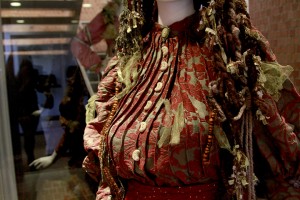
Madison Miller | Assistant Broadcast Producer
Staff Writer
Baylor’s theater department has acquired a new technology that will help them pave the way for their future productions.
A 3-D printer provides new accessories for costumes designed for recent and upcoming shows.
Joe Kucharski, assistant professor of theater arts, said the printer is part of his research on 3-D printing in apparel manufacturing. So far, the printer has proven to be a great success, he said.
“We just used it for the show ‘Into the Woods,” Kucharski said. “The buttons and decor of the witch’s costume in the show came from the 3-D printer.”
Now, because of the printer, Kucharski said that they are free to adapt creations and add to different costumes for inexpensive prices compared to before.
“It’s definitely beneficial for us,” he said. “Bringing in this new technology is a really valuable tool.”
Kurcharski said that the printer works much like a fancy hot glue gun would. After digitally designing the accessory for a given costume through a special software, plastic material is heated and laid down in the printer where it is printed in whatever form was designed by the computer.
“Right now, we’re just using it for the jewelry, buttons and elements of a costume, which are all made of plastic right now,” Kucharski said. “Students will also learn about it in class and the design faculty will integrate it with their lessons.”
Dr. Stan Denman, chairman of the theater department, said the printer is giving students and faculty the chance to work with something new and advancing their educational opportunities.
“We used to have an early model of a 3-D printer and it just did not perform very well,” Denman said. “Now, we’ve been able to add elements and details we couldn’t have added before.”
According to Wohlers Associates, one of the leading firms studying 3-D printing and its market impact, the sale of 3-D printing products and services will approach $6 billion worldwide in the next four years. Companies such as NASA are even exploring the possibility of using a 3-D printer on deep space missions for food items.
With the current rise of the 3-D printer and technological advancement, Kucharski said he wants to introduce this to students and provide a more in-depth design process for future shows.
“We’re excited for this new technology and we’re excited to use this in all our shows,” he said. “It’s great to be able to customize costume pieces and execute it in a way that’s now possible.”





